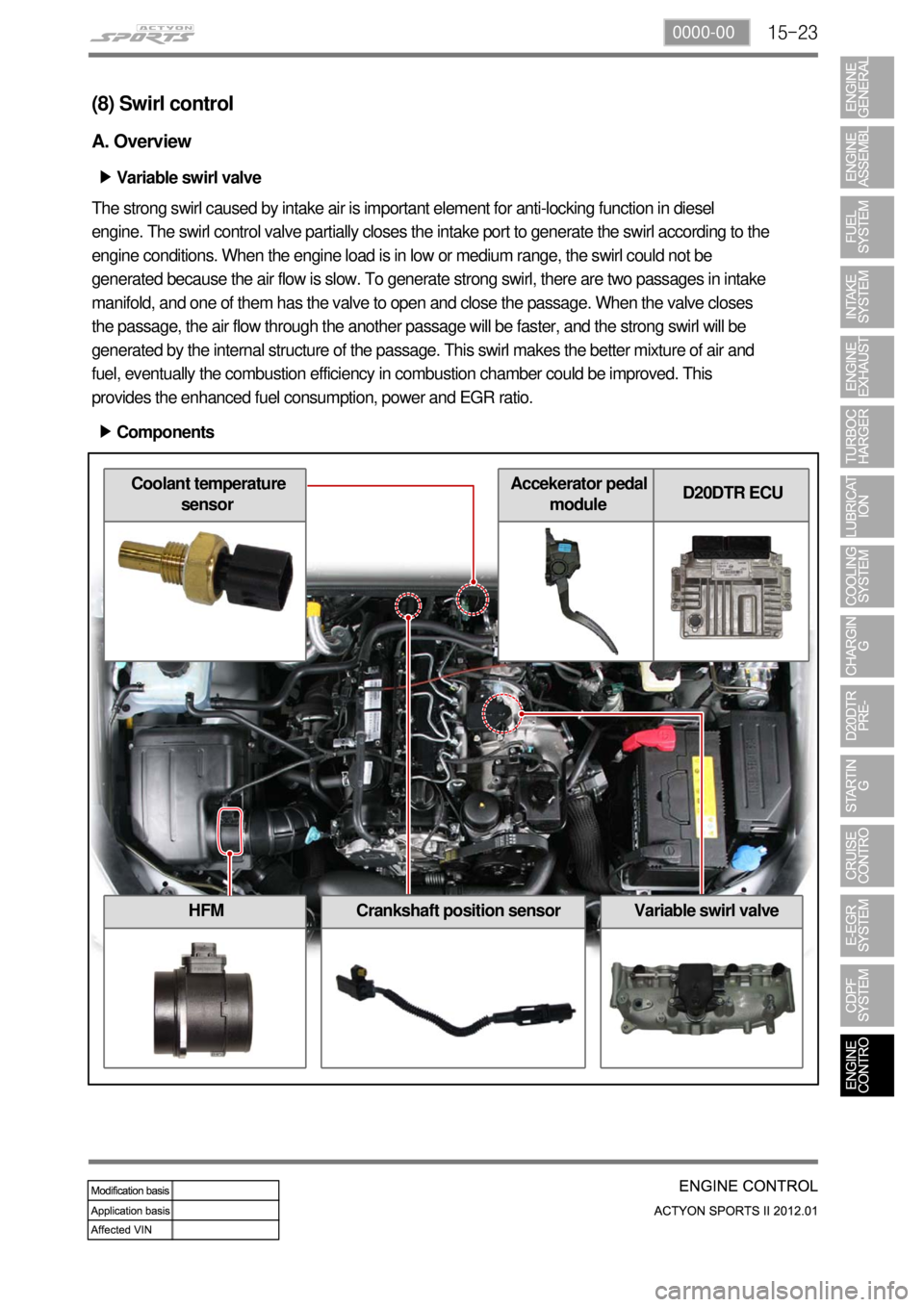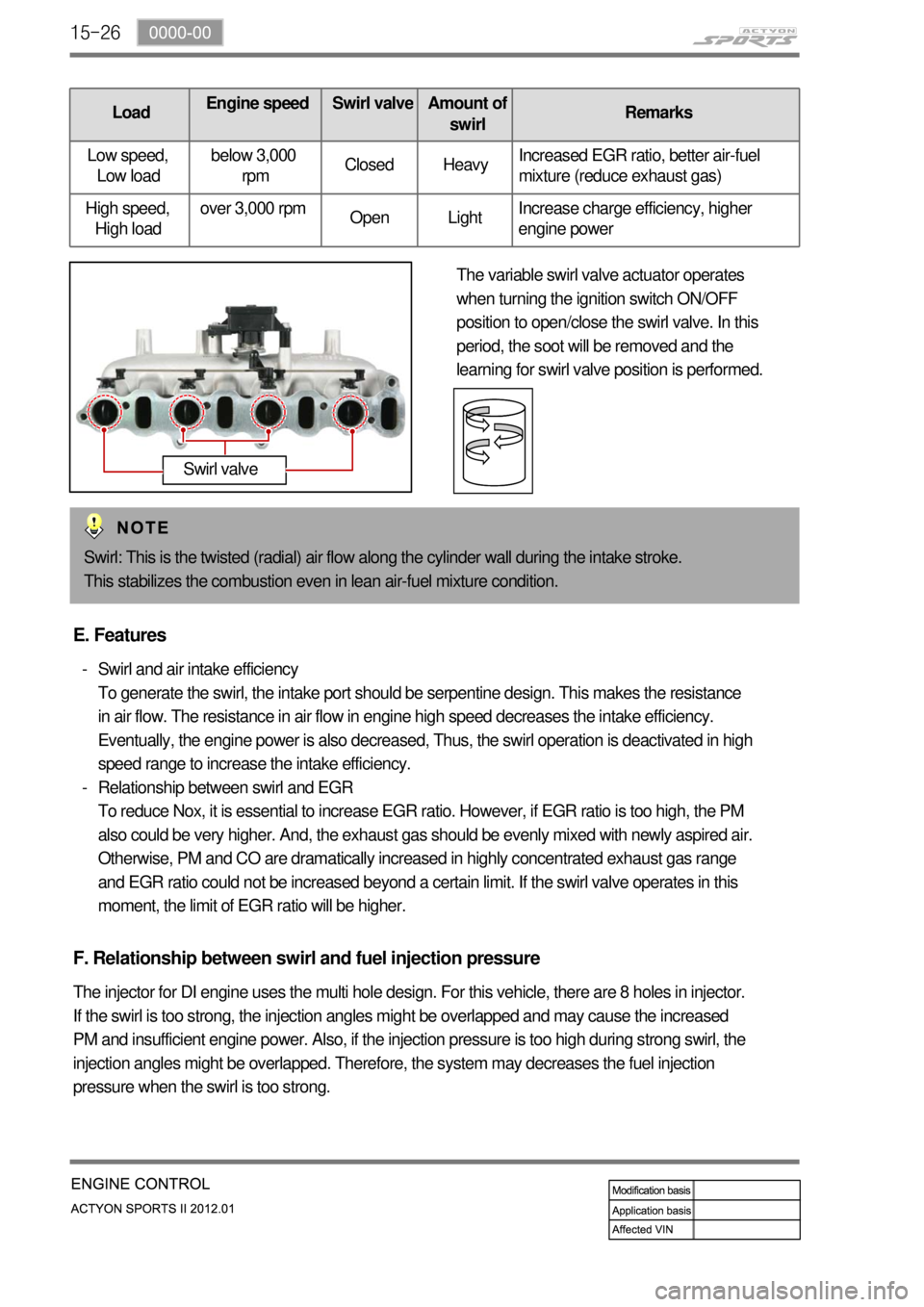Page 326 of 828

15-230000-00
(8) Swirl control
A. Overview
Variable swirl valve ▶
The strong swirl caused by intake air is important element for anti-locking function in diesel
engine. The swirl control valve partially closes the intake port to generate the swirl according to the
engine conditions. When the engine load is in low or medium range, the swirl could not be
generated because the air flow is slow. To generate strong swirl, there are two passages in intake
manifold, and one of them has the valve to open and close the passage. When the valve closes
the passage, the air flow through the another passage will be faster, and the strong swirl will be
generated by the internal structure of the passage. This swirl makes the better mixture of air and
fuel, eventually the combustion efficiency in combustion chamber could be improved. This
provides the enhanced fuel consumption, power and EGR ratio.
Components ▶
HFMCrankshaft position sensorVariable swirl valve
Coolant temperature
sensorAccekerator pedal
moduleD20DTR ECU
Page 328 of 828

15-250000-00
C. Types of swirl
Swirl: One cylinder has two intake air ports, one is set horizontally
and the other one is set vertically. Swirl is the horizontal air flows in
cylinder due to the horizontal intake air ports.
Tumble: Tumble is the vertical air flows in cylinder due to the
vertical intake air port
Tumble: Tumble is the vertical air flows in cylinder due to the
vertical intake air port
D. Swirl control
In DI type diesel engine, the liquefied fuel is injected into the cylinder directly. If the fuel is evenly
distributed in short period, the combustion efficiency could be improved. To get this, there should
be good air flow in cylinder. In general, there are two intake ports, swirl port and tangential port, in
each cylinder. The swirl port generates the horizontal flow and the tangential port generates the
longitudinal flow. In low/mid load range, the tabgential port is closed to increase the horizontal
flow. Fast flow decreases the PM during combustion and increases the EGR ratio by better
combustion efficiency.
Page 329 of 828

15-26
LoadEngine speed Swirl valveAmount of
swirlRemarks
Low speed,
Low loadbelow 3,000
rpmClosed HeavyIncreased EGR ratio, better air-fuel
mixture (reduce exhaust gas)
High speed,
High loadover 3,000 rpm
Open LightIncrease charge efficiency, higher
engine power
The variable swirl valve actuator operates
when turning the ignition switch ON/OFF
position to open/close the swirl valve. In this
period, the soot will be removed and the
learning for swirl valve position is performed.
Swirl: This is the twisted (radial) air flow along the cylinder wall during the intake stroke.
This stabilizes the combustion even in lean air-fuel mixture condition.
Swirl valve
E. Features
Swirl and air intake efficiency
To generate the swirl, the intake port should be serpentine design. This makes the resistance
in air flow. The resistance in air flow in engine high speed decreases the intake efficiency.
Eventually, the engine power is also decreased, Thus, the swirl operation is deactivated in high
speed range to increase the intake efficiency.
Relationship between swirl and EGR
To reduce Nox, it is essential to increase EGR ratio. However, if EGR ratio is too high, the PM
also could be very higher. And, the exhaust gas should be evenly mixed with newly aspired air.
Otherwise, PM and CO are dramatically increased in highly concentrated exhaust gas range
and EGR ratio could not be increased beyond a certain limit. If the swirl valve operates in this
moment, the limit of EGR ratio will be higher. -
-
F. Relationship between swirl and fuel injection pressure
The injector for DI engine uses the multi hole design. For this vehicle, there are 8 holes in injector.
If the swirl is too strong, the injection angles might be overlapped and may cause the increased
PM and insufficient engine power. Also, if the injection pressure is too high during strong swirl, the
injection angles might be overlapped. Therefore, the system may decreases the fuel injection
pressure when the swirl is too strong.
Page 337 of 828
15-34
HFM (intake air
temperature)CDPF
Electric throttle
bodyCoolant
temperature senso
r
Oxygen sensor
Injector (C3I)
E-EGR valve
(11) Wide band oxygen sensor control
A. Overview
For diesel engine, combustion is not performed at the optimum (theoretically correct) air-fuel ratio
and the oxygen concentration is thin in most cases. So the wide-band oxygen sensor is used for
this kind of engine, and this sensor is a little different from the one that used for gasoline engine.
The combustion in diesel engine is controlled by fuel injection volume. Therefore, the wide band
oxygen sensor should be used in diesel engine. This sensor measures the air-fuel ratio in very
wide range, and is also called full range oxygen sensor.
The wide band oxygen sensor measures the oxygen density in exhaust gas and sends it to
ECU to control the EGR more precisely. -
B. Components
D20DTR ECU
Page 350 of 828

15-470000-00
Diff. pres. sensor: Measure
pressure between front sid
e
and rear side of CDPF
ECU (DCM 3.7)
Injector: Control post
injection
D. Operation process
When the differential pressure sensor detects the pressure difference between the front and the
rear side of CDPF, the sensor sends signal indicating the soot is accumulated and the post
injection is performed to raise the temperature of exhaust gas. The amount of fuel injected is
determined according to the temperature of exhaust gas detected by the rear temperature sensor.
If the temperature is below 600°C, the amount of fuel injected is increased to raise the
<009b008c00940097008c00990088009b009c0099008c005500470070008d0047009b008f008c0047009b008c00940097008c00990088009b009c0099008c00470090009a00470096009d008c00990047005d0057005700b6006a00530047009b008f008c00
47008800940096009c0095009b00470096008d0047008d009c>el injected is decreased or not
controlled. When the engine is running in low load range, the amount of post injection and the
amount of intake air are controlled. It is to raise the temperature by increasing the amount of fuel
while decreasing the amount of intake air.
Front EGT sensor: Measure
DOC temp.
Rear EGT sensor: Measure
DPF temp.
Electronic throttle body
Control intake air mass
T-MAP sensor
Intake air
mass
Exceed PM
limitBooster
pressure/
temperaturePost injection
Control intake
air mass
Page 351 of 828

15-48
E. Cautions
Use only specified Engine Oil (approved by MB Sheet 229.51) for CDPF. -
Use only specified engine oil (Low Ash Oil) ▶
The vehicle equipped with CDPF should use specific engine oil to improve the engine
performance and fuel economy, and ensure the service life of CDPF. -
Issue with normal engine oil ▶
Sulfur, one of the contents of engine oil is burned and generates soot that is not regenerated
by the DPF. This remains on the filter as ashes and keeps accumulating. Eventually, this
ashes will block the filter. -
Benefit for specified engine oil ▶
Minimized the sulfur content of engine oil which reduces the service life.
Improved fuel economy and emission level of CO2 with high performance and low viscosity.
Increased service life of engine oil with high resistance to temperature. -
-
-
Problems when using unspecified engine oil ▶
The service life of filter may be reduced by 30% or more by the ashes accumulated on the
filter.
The fuel economy may be reduced because of engine rolling resistance, frequent
regeneration of DPF. -
-
These problems are also caused by oil with high sulfur content, such as tax exemption oil
and heating oil, etc. *
Page 358 of 828
01-8
Front View ▶
NO. FUNCTION NO. FUNCTION
1 HFM Sensor 12 Intake Manifold
2 Intake Air Duct 13 Cylinder Head
3 Cylinder Head Cover 14 Exhaust Manifold
4 Ignition Coi 15 Dipstick Guide Tube and Gauge
5 Spark Plug Connector 16 Connecting Rod
6 Fuel Distributor 17 Crankshaft
7 Injector 18 Engine Mounting Bracket
8 Exhaust Camshaft 19 Starter
9 Intake Camshaft 20 Crankcase
10 Valve Tappet 21 Oil Pump Sprocket
11 Intake Valve 22 Oil Pan
NO. FUNCTION NO. FUNCTION
23 Camshaft Adjuster 29 Oil Pump Drive Chain
24 Oil Filler Cap 30 Oil Strainer
25 Engine Hanger Bracket 31 Oil Pump
26 Cooling Fan and Viscous Clutch 32 Ring Gear and Flywheel of Drive Plate
27 Oil Filter 33 Piston
28 Timing Chain
Side View ▶
Page 376 of 828

03-4
1. DESCRIPTION AND OPERATION
1) Exhaust System
When you are inspecting or replacing exhaust system components, make sure there is adequate
clearance from all points on the underbody to avoid possible
overheating of the floor panel and possible damage to the passenger compartment insulation
and trim materials.
Check the complete exhaust system and the nearby body areas and trunk lid for broken,
damaged, missing or mispositioned parts, open seams, holes, loose connections, or other
deterioration which could permit exhaust fumes to seep into the trunk may be an indication of a
problem in one of these areas. Any defects should be corrected immediately.
2) Catalytic Converter (Gasoline Engine)
When jacking or lifting the vehicle from the body side rails, be certain that the lift pads do not
contact the catalytic converter, as this could damage the catalytic converter.
Use of anything other than unleaded fuel will damage the catalyst in the catalytic converter. 1.
2.
Catalytic Converter Structure ▶
The Catalytic converter of monolith type consists
of 2 walled metal bodies which is made of
Cordierite. The principal element of converter
consists of the materials like Alumina or oxidized
Serume in order to apply to Ceramic Monolith.
Washer coat operates first, and catalytic metal
elements (Pt, Pd, Rh) operates to washer coat
next.
Monolith type is lighter than other types, easy to
manufacture and quickly approaches to proper
temperature. Washer coat is used to make a
contact surface with exhaust gas bigger by
adhering closely to small holes
of inner layer. If a lead compound or phosphorus
adheres to the surface and the temperature rises,
its surface is decreased. The total area of general
monolith converter is about 45, 000~500,000ft3.
(10 times of a football field) Generally
Alumina
(AL2 O3) is used as a raw materialand its 7
phases of gamma, delta, theta have big areas and
high stability for the temperature, and nowadays
gamma Alumina is used usually.